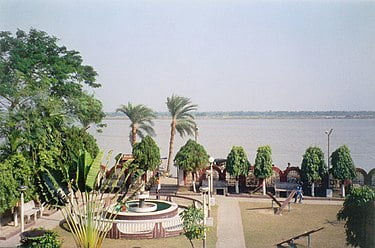Ichamati River

Ichamati River (Bengali: ইছামতী নদী) (also spelt Ichhamati), is a trans-boundary river which flows through India and Bangladesh and also forms the boundary between the two countries.[1] The river is facing the problem of siltation leading to thin flow of water in the dry season and floods in the rainy season. Experts are handling the situation and remedial matters are being discussed between the governments of India and Bangladesh.[2]
Ichamati River is now in three parts: (1) The longer part flows from the Mathabhanga River, a distributary of the Padma, and after flowing for 208 kilometres (129 mi) joins the Kalindi River near Hasnabad in North 24 Parganas and Debhata in Satkhira District. (2) Once the main river west of Dhaka and (3) Ichamati of Dinajpur. Rennel’s map of 1764–66, shows the last two rivers as one. According to a number of hydrologists, the three Ichamati rivers, in the past, were a single channel.[1][2] The second river marked above originates south of Jafarganj opposite to the mouth of the Hoorsagar near Nathpur factory and runs towards Joginighat in Munshiganj. Joginighat is situated at the confluence of the Jamuna and the Ichamati. There are five pilgrimage ghats along the river locally known as Panchatirtha ghats—Tirthaghat, Agla, Solepur, Barunighat and Joginighat.[1]
The Mathabhanga River originates from the right bank of the Padma, at Munshiganj in Kushtia District in Bangladesh. It bifurcates near Majidia in Nadia District in India, creating two rivers, Ichamati and Churni. After traversing a length of 19.5 kilometres (12.1 mi) in India, the Ichamati enters Bangladesh near Mubarakpur. It flows for 35.5 kilometres (22.1 mi) in Bangladesh and again enters India at Habaspur Village near Duttaphulia in Nadia district. It forms the international border between India and Bangladesh for 21 kilometres (13 mi) from Angrail to Kalanchi, and again from Goalpara to the Kalindi-Raimangal outfall into the Bay of Bengal.[2]
The Bhairab once flowed from the Ganges, across the present beds of the Jalangi, and further eastwards towards Faridpur. The Bhairab is no more a very active river. The Mathabhanga is a younger stream than Jalangi and it was not till very recently that the river completed its junction with the Hooghly by adopting the River Churni (now its lower reaches) for its main course. Earlier most of the water of the Mathabhanga ran off to the east down the Kumara, Chitra, Coboduk (Bhairab), and Ichamati, but all these escape routes have been shut off, except a small amount for the Ichamati. The point to note is that while earlier the rivers in the region flowed in a south-easterly direction, but later some force pulled the Jalangi and the Mathabhanga in a south-westerly direction. The inference is that it occurred because of a local subsidence, which was active for some period prior to 1750 and which has since become inactive.[3]
